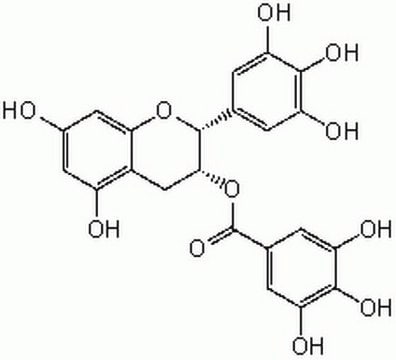E4268
(−)-Epigallocatechin gallate
≥80% (HPLC), from green tea
Synonim(y):
(−)-cis-2-(3,4,5-Trihydroxyphenyl)-3,4-dihydro-1(2H)-benzopyran-3,5,7-triol 3-gallate, (−)-cis-3,3′,4′,5,5′,7-Hexahydroxy-flavane-3-gallate, EGCG
About This Item
Polecane produkty
pochodzenie biologiczne
green tea
Próba
≥80% (HPLC)
Zastosowanie
metabolomics
vitamins, nutraceuticals, and natural products
temp. przechowywania
2-8°C
ciąg SMILES
Oc1cc(O)c2C[C@@H](OC(=O)c3cc(O)c(O)c(O)c3)[C@H](Oc2c1)c4cc(O)c(O)c(O)c4
InChI
1S/C22H18O11/c23-10-5-12(24)11-7-18(33-22(31)9-3-15(27)20(30)16(28)4-9)21(32-17(11)6-10)8-1-13(25)19(29)14(26)2-8/h1-6,18,21,23-30H,7H2/t18-,21-/m1/s1
Klucz InChI
WMBWREPUVVBILR-WIYYLYMNSA-N
informacje o genach
human ... CYP1A2(1544)
Szukasz podobnych produktów? Odwiedź Przewodnik dotyczący porównywania produktów
Opis ogólny
Zastosowanie
- a potential neuroprotective agent to test its protective effect against spinal cord injury and blood-spinal cord barrier (BSCB) leakage
- an effective antioxidant against light-induced photoreceptor degeneration in mice retina
- an antioxidant in retinitis pigmentosa (RP) and reduces oxidative damage and changes circadian rhythms in pigmented heterozygous P23H rat
- to test its reversal effect on Diastolic dysfunction in restrictive cardiomyopathy (RCM) mice
- an anti-cancer agent in colorectal cancer in mice
Działania biochem./fizjol.
Hasło ostrzegawcze
Warning
Zwroty wskazujące rodzaj zagrożenia
Zwroty wskazujące środki ostrożności
Klasyfikacja zagrożeń
Acute Tox. 4 Oral - Aquatic Chronic 2 - Eye Irrit. 2 - Skin Sens. 1
Kod klasy składowania
11 - Combustible Solids
Klasa zagrożenia wodnego (WGK)
WGK 2
Temperatura zapłonu (°F)
Not applicable
Temperatura zapłonu (°C)
Not applicable
Środki ochrony indywidualnej
Eyeshields, Gloves, type N95 (US)
Certyfikaty analizy (CoA)
Poszukaj Certyfikaty analizy (CoA), wpisując numer partii/serii produktów. Numery serii i partii można znaleźć na etykiecie produktu po słowach „seria” lub „partia”.
Masz już ten produkt?
Dokumenty związane z niedawno zakupionymi produktami zostały zamieszczone w Bibliotece dokumentów.
Klienci oglądali również te produkty
Produkty
Antioxidants protect biological systems from oxidative damage produced by oxygen-containing free radicals and from redoxactive transition metal ions such as iron, copper, and cadmium.
Nasz zespół naukowców ma doświadczenie we wszystkich obszarach badań, w tym w naukach przyrodniczych, materiałoznawstwie, syntezie chemicznej, chromatografii, analityce i wielu innych dziedzinach.
Skontaktuj się z zespołem ds. pomocy technicznej










